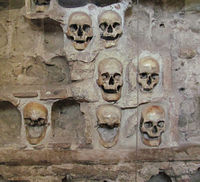This is an old revision of this page, as edited by Amanuensis Balkanicus (talk | contribs) at 03:03, 6 October 2013 (adding a map). The present address (URL) is a permanent link to this revision, which may differ significantly from the current revision.
Revision as of 03:03, 6 October 2013 by Amanuensis Balkanicus (talk | contribs) (adding a map)(diff) ← Previous revision | Latest revision (diff) | Newer revision → (diff)Historic site in Niš, Serbia
| Skull Tower Ćele kula Ћеле Кула | |
|---|---|
 A detail from a wall in the tower A detail from a wall in the tower | |
| Location | Niš, Serbia |
| Built | 1809 |
 | |
The Skull Tower (Template:Lang-sr) is a tower composed of human skulls located in the city of Niš, Serbia. Made from the skulls of killed Serbian revolutionaries, it was constructed on the orders of Hurshid Pasha, the Turkish Grand Vizier of Niš, following the 1809 Battle of Čegar fought during the First Serbian Uprising. After the Serbian re-capture of Niš in 1878, the tower was roofed over and in 1892 a chapel was built around it. In the ensuing decades, it has become a popular tourist attraction and symbol of Serbian independence.
History

The First Serbian Uprising against the Ottoman Empire erupted in 1804, with Karađorđe Petrović as its leader. On 19 May 1809, 3,000 Serbian revolutionaries led by commander (Template:Lang-sr) Stevan Sinđelić were attacked by a large Turkish force on Čegar Hill, located close to the city of Niš. Owing to a lack of coordination between Serb commanders, the revolutionaries failed to receive any support from other Serbian rebel detachments. Despite this, the numerically superior Turks lost thousands of troops in numerous attacks against the Serb positions. Eventually, the Serbian revolutionaries were overwhelmed and Turkish soldiers swarmed their trenches. Not wishing for him and his men to be captured and killed by impalement, Sinđelić fired his pistol into his entrenchment's powder magazine. The resulting explosion killed him and all the Serb revolutionaries and Turkish soldiers in the vicinity.
Afterwards, the Turkish Grand Vizier of Niš, Hurshid Pasha, ordered that the heads of Sinđelić and his men be skinned, stuffed and sent to the Ottoman Sultan Mahmud II. The Turks then built the Skull Tower (Template:Lang-sr) as a warning to future generations intending to revolt against the Ottoman Empire. It consisted of 952 Serbian skulls imbedded on four sides in fourteen rows. In the ensuing years, many skulls fell out from the tower walls, some were taken away for burial by relatives thinking they could identify the skulls of their deceased family members, and some were taken by souvenir hunters. Following the Serbian re-capture of Niš from the Ottomans in 1878, the tower was roofed over to protect it from the elements and in 1892 a chapel was built around it. As of 2013, fifty-four skulls remain, with one resting in a glass case reputed to be that of Sinđelić himself. In the years following its construction, the tower became a symbol of Serbian independence and a place of pilgrimage for Serbs. Prior to the dissolution of Yugoslavia, tens of thousands of schoolchildren from across Yugoslavia visited it.
Gallery
See also
Notes
- Judah 2002, p. 51. sfn error: no target: CITEREFJudah2002 (help)
- ^ Morrison 1942, p. xxii.
- ^ Judah 2002, p. 279. sfn error: no target: CITEREFJudah2002 (help)
- Morrison 1942, p. xxiii.
- ^ Judah 2002, p. 280. sfn error: no target: CITEREFJudah2002 (help)
- Vankovska & Wiberg 2003, p. 228.
References
- Judah, Tim (2000). The Serbs: History, Myth and the Destruction of Yugoslavia. New Haven, Connecticut: Yale University Press. ISBN 978-0-300-08507-5.
{{cite book}}: Invalid|ref=harv(help) - Morrison, Walter Angus (1942). "The Revolt of the Serbs Against the Turks: 1804–1813". Cambridge: Cambridge University Press. ISBN 978-110-7-67606-0.
{{cite web}}: Invalid|ref=harv(help) - Vankovska, Biljana; Wiberg, Haken (2003). Between Past and Future: Civil-Military Relations in Post-Communist Balkan States. London: I.B.Tauris. ISBN 978-1-86064-624-9.
{{cite book}}: Invalid|ref=harv(help)
External links
Template:Cultural Heritage of Serbia 43°18′42″N 21°55′26″E / 43.31167°N 21.92389°E / 43.31167; 21.92389
Categories:
